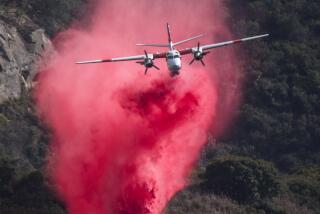Angel Flight Lives Up to Name, and It Fits : Mercy missions: The reward is the deed for the volunteers who airlift indigent patients to hospitals around the state.
SAN GABRIEL VALLEY — The pilots call their service Angel Flight, and the people they help say the name fits.
For the 450 volunteers who ferry indigent patients with catastrophic illnesses to hospitals around the state, the reward is the deed.
“It’s what you get, not what you give,” Lani Griswold of South Pasadena said of the satisfaction she feels. Last year, she and her husband, Jim, flew out of El Monte Airport to pick up a frail 9-year-old boy suffering from leukemia and take him for treatment in Palo Alto. They have been making missions of mercy in their four-seat Piper Cherokee ever since.
Francisco Gonzalez--Cisco, as he is called--lives with his family in Tulare, a small city in central California between Bakersfield and Fresno. The sophisticated treatment he needs is unavailable nearby.
The family was referred to Louise Packard Children’s Hospital at Stanford Medical Center but could not afford the transportation to Palo Alto. Angel Flight stepped in.
“The pilots were so nice and so caring,” said Mary Ojeda, 27, Cisco’s mother.
The Griswolds have flown Cisco five times, always at their own expense. A one-way run from Tulare to Palo Alto costs $60 in fuel alone. Although there is some tax benefit, said Jim Weaver, executive director of Angel Flight in California, every pilot bears the expense of the missions he or she flies.
“Angel Flight pilots are in all walks of life but they don’t consider the expense,” Lani Griswold said. “Some actually rent a plane in order to fly a mission.”
Inspired by similar groups in other parts of the country, a group of pilots in Santa Monica formed the California chapter of Angel Flight in 1983. The nonprofit organization was run by volunteers until Jan. 1, 1992, when Weaver, 49, was hired to manage the office full time and raise funds for operating expenses. Part-time staff members coordinate the flights. Last year, the pilots flew about 600 missions.
The Griswolds, like many Angel Flight members, are retirees. When they first retired, they planned to fly Christian missionaries around the world for Redlands-based Mission Aviation Fellowship.
“But the numbers were against me,” said Jim Griswold, 60, who was a researcher for Southern California Edison Co. “My age was too high and my flying hours too low.”
Then the couple heard about Angel Flight. For them, the last year has been the most meaningful of their lives.
“I thought it would be depressing to deal with people with medical problems,” Jim Griswold said. “But all the people we’ve met have been tremendous people--upbeat. The thing that flabbergasts me--these people are dealing with the real basic issues.”
“They enjoy every minute of living,” said Lani Griswold, 61, who works part time as a school nurse for Los Angeles city schools. “When we picked up Cisco in Tulare, he saw some strawberry plants. He was thrilled over such an ordinary thing.”
“Now every time we call Angel Flight, the Griswolds want to take us,” Ojeda said. “They’re wonderful. One time, they even drove us to the hospital and stayed with us in the waiting room, and stayed overnight somewhere so they could fly us back the next day.”
The Griswolds have bonded with Cisco, but he is not their only passenger, nor are they his only pilots. “No specific attempt is made to keep a pilot with the same patient,” Weaver said.
Angel Flight gets referrals from hospitals and social agencies throughout the state. Passengers must be ambulatory and stable, which means they must be able to get in and out of the plane and sit during the flight. Pilots do not give medical aid.
Angel Flight pilots must be licensed and demonstrate their flying skills to a “check pilot.” The only requirement of a co-pilot is to be caring and reassuring to the patient.
Although most passengers are cancer victims, not all have the disease. A few are autistic children who need to be flown to treatment. Occasionally, Angel Flight flies donor organs to a hospital where a recipient is waiting.
Some of Angel Flight’s good deeds are less tangible, such as helping families cope with the emotional toll of long-term illness.
When the need for treatment lasts months or years, “the family may no longer be able to take the time they did in the beginning when they were so very committed,” said Nellie Garcia, director of clinical social work at the City of Hope in Duarte.
“(Angel Flight) allows the families to resume their normal schedule of living and the patients to know there’s somebody out there for them.”
But Lani Griswold is worried. “Somewhere out there,” she said, “there must be somebody who really needs the service and doesn’t know about it.”
More to Read
Sign up for Essential California
The most important California stories and recommendations in your inbox every morning.
You may occasionally receive promotional content from the Los Angeles Times.










